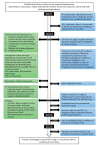Giant Primary Cutaneous Nodular Melanoma of the Forehead: A Case Report
- PMID: 39727823
- PMCID: PMC11728223
- DOI: 10.3390/geriatrics9060164
Giant Primary Cutaneous Nodular Melanoma of the Forehead: A Case Report
Abstract
Background: The incidence of melanoma is increasing globally. The estimated worldwide incidence is projected to increase from 324,635 cases in 2020 to 510,000 in 2040. In the UK, melanoma accounts for 4% of all new cases of cancer. Melanomas occurring in the skin of the head and neck represent 13% and 23% of cases in women and men, respectively. Prognostic indicators include presence of nodal or distant metastasis, ulceration, and Breslow thickness, where >4 mm thickness predicts poorest overall survival rates. Giant melanomas, a term generally applied to melanomas larger than 5-10 cm, are rare and often have a very poor prognosis. Clinical case: An 82-year-old female presented acutely with a 2-3-day history of delirium and urinary retention in February 2022. In addition, she was noted to have a large fungating growth on her forehead that obscured the bridge of the nose and had been slowly increasing in size for the past year prior to admission. She had initially presented in primary care with a small growth on her forehead but declined further investigations for fear of contracting COVID-19. She consented to having further assessment and management of the forehead mass. A shave biopsy revealed giant nodular melanoma, specifically, the largest melanoma of the face reported in the literature. Remarkably, our patient underwent a successful complete excision and skin grafting, with no evidence of recurrence or distal metastasis after 2 years of follow up. Conclusions: This case highlights the anxieties people felt about contracting COVID-19 when national guidelines recommended shielding that had resulted in further morbidity. Despite poor prognostic factors, clinically and histologically, our patient did not need any systemic anticancer therapy nor radiotherapy. She was well after 2 years follow up without any signs of recurrence.
Keywords: giant nodular melanoma; older person; surgical resection.
Conflict of interest statement
S.M., C.J.-L. and M.S. have nothing to declare. H.P.P. has received lecture fees from Abbott, Pfizer, and HC-UK conferences outside of the submitted work.
Figures




Similar articles
-
Margins of excision for cutaneous melanoma of the eyelid skin: the Collaborative Eyelid Skin Melanoma Group Report.Ophthalmic Plast Reconstr Surg. 2003 Mar;19(2):96-101. doi: 10.1097/01.IOP.0000056141.97930.E8. Ophthalmic Plast Reconstr Surg. 2003. PMID: 12644753
-
Merkel cell carcinoma of the forehead area: a literature review and case report.Oral Maxillofac Surg. 2019 Sep;23(3):365-373. doi: 10.1007/s10006-019-00793-y. Epub 2019 Jul 24. Oral Maxillofac Surg. 2019. PMID: 31342210 Review.
-
Management of refractory metastatic anal squamous cell carcinoma following disease progression on traditional chemoradiation therapy.J Adv Pract Oncol. 2012 May;3(3):161-9. doi: 10.6004/jadpro.2012.3.3.4. J Adv Pract Oncol. 2012. PMID: 25031942 Free PMC article.
-
Head and neck melanoma in 534 clinical Stage I patients. A prognostic factors analysis and results of surgical treatment.Ann Surg. 1984 Dec;200(6):769-75. doi: 10.1097/00000658-198412000-00017. Ann Surg. 1984. PMID: 6508408 Free PMC article.
-
Giant malignant melanoma of the upper limb: a case report and review of the literature.J Med Case Rep. 2025 May 18;19(1):234. doi: 10.1186/s13256-025-05303-1. J Med Case Rep. 2025. PMID: 40383796 Free PMC article. Review.
References
-
- Heistein J.B., Acharya U., Mukkamalla S.K.R. StatPearls. StatPearls Publishing LLC.; Treasure Island, FL, USA: 2024. Malignant Melanoma. - PubMed
-
- Elder D.E., Bastian B.C., Cree I.A., Massi D., Scolyer R.A. The 2018 World Health Organization Classification of Cutaneous, Mucosal, and Uveal Melanoma: Detailed Analysis of 9 Distinct Subtypes Defined by Their Evolutionary Pathway. Arch. Pathol. Lab. Med. 2020;144:500–522. doi: 10.5858/arpa.2019-0561-RA. - DOI - PubMed
Publication types
LinkOut - more resources
Full Text Sources
Miscellaneous

